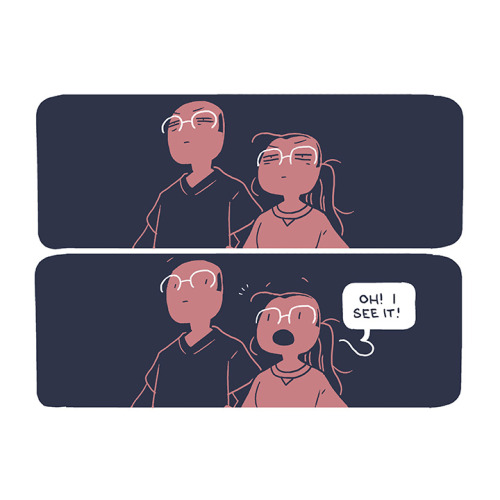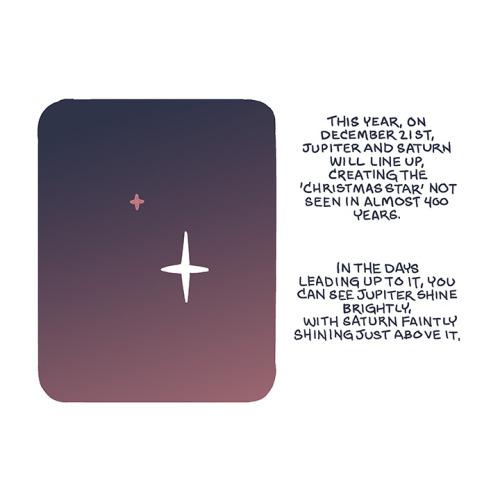Geocentric Map Of The Solar System.

Geocentric map of the Solar System.
More Posts from Fillthevoid-with-space and Others

Great detail of the famous crawler that transported the mighty Saturn V and all the space shuttles to the launch pads. An engineering feat in its own right.



Description: A four panel comic. In the first two panels, me and my father are squinting at the night sky before I brighten and declare that ‘OH! I see it!’ In the next panel is the night sky with two stars. One bright one in the lower right center and a slightly dimmer one just above and to the left of the first one. Text reads: ‘This year, on December 21st, Jupiter and Saturn will line up, creating the ‘Christmas Star’ not seen for almost 400 years. In the days leading up to it, you can see Jupiter shine brightly, with Saturn faintly shining just above it.’ In the final panel I am closing my window and looking up at the sky. Captions read: ‘I keep looking up, finding and refinding it.’ And ‘The planets are always there, but this moment makes it all seem so fleeting.’

Inner corona and prominences during Monday’s total solar eclipse
via reddit

We will not leave the crew hanging!
The crew module uprighting system rotates Orion should it come to rest upside down when landing in the water.






The Meaning of Color in Hubble Images: An interactive slideshow that illustrates how the Hubble Space Telescope incorporates light in multiple wavelengths to produce it’s stunning imagery.
Does an ecplispe cause any unusual effects on the Earth?
Yes, and this is one of the things we’re hoping to study more with this eclipse! If you are in totality, you’ll notice a significant temperature drop. We are also expecting to see changes in the Earth’s atmosphere and ionosphere. You can help us document these changes using the GLOBE Observer app https://www.globe.gov/globe-data/data-entry/globe-observer ! There are lots of great citizen science going on during this eclipse, and we’d love to have everyone here helping out! https://eclipse2017.nasa.gov/citizen-explorers
Just a reminder that the first NASA astronauts were supposed to be women because generally they are smaller, lighter (less weight in the cockpit means less fuel required) and eat less than men and so would be easier to accommodate in space.

You may recognize the seventh picture in the slideshow--it’s my profile picture here. Happy birthday Hubble, you’re older than I am!
Hubble Spots Two Interacting Galaxies Defying Cosmic Convention
NASA - Hubble Space Telescope patch. March 24, 2017
Some galaxies are harder to classify than others. Here, Hubble’s trusty Wide Field Camera 3 (WFC3) has captured a striking view of two interacting galaxies located some 60 million light-years away in the constellation of Leo (The Lion). The more diffuse and patchy blue glow covering the right side of the frame is known as NGC 3447 — sometimes NGC 3447B for clarity, as the name NGC 3447 can apply to the overall duo. The smaller clump to the upper left is known as NGC 3447A. Overall, we know NGC 3447 comprises a couple of interacting galaxies, but we’re unsure what each looked like before they began to tear one another apart. The two sit so close that they are strongly influenced and distorted by the gravitational forces between them, causing the galaxies to twist themselves into the unusual and unique shapes seen here. NGC 3447A appears to display the remnants of a central bar structure and some disrupted spiral arms, both properties characteristic of certain spiral galaxies. Some identify NGC 3447B as a former spiral galaxy, while others categorize it as being an irregular galaxy.
Hubble Space Telescope
For Hubble’s image of the Whirlpool Galaxy, visit: http://hubblesite.org/ http://www.nasa.gov/hubble http://www.spacetelescope.org/ Image, Animation, Credits: ESA/Hubble & NASA/Text Credits: European Space Agency/NASA/Karl Hille. Best regards, Orbiter.ch Full article
-
 davvero-annoiatx liked this · 10 months ago
davvero-annoiatx liked this · 10 months ago -
 makinmuffins liked this · 4 years ago
makinmuffins liked this · 4 years ago -
 squeackygee liked this · 4 years ago
squeackygee liked this · 4 years ago -
 honestlybabyitscool liked this · 4 years ago
honestlybabyitscool liked this · 4 years ago -
 mrenjoyable liked this · 4 years ago
mrenjoyable liked this · 4 years ago -
 cupids--bow liked this · 4 years ago
cupids--bow liked this · 4 years ago -
 oxxxxc1zzzzzzzzzzzzz7 reblogged this · 5 years ago
oxxxxc1zzzzzzzzzzzzz7 reblogged this · 5 years ago -
 oxxxxc1zzzzzzzzzzzzz7 liked this · 5 years ago
oxxxxc1zzzzzzzzzzzzz7 liked this · 5 years ago -
 russiantweakerstud liked this · 5 years ago
russiantweakerstud liked this · 5 years ago -
 heartbound reblogged this · 5 years ago
heartbound reblogged this · 5 years ago -
 orelon reblogged this · 5 years ago
orelon reblogged this · 5 years ago -
 prometheusascendant liked this · 5 years ago
prometheusascendant liked this · 5 years ago -
 robbobertson8 liked this · 6 years ago
robbobertson8 liked this · 6 years ago -
 retconair-moved reblogged this · 6 years ago
retconair-moved reblogged this · 6 years ago -
 anyday-happyday liked this · 6 years ago
anyday-happyday liked this · 6 years ago -
 prometheusascendant reblogged this · 6 years ago
prometheusascendant reblogged this · 6 years ago -
 saprophytesuccourer liked this · 6 years ago
saprophytesuccourer liked this · 6 years ago -
 the-sloth-king liked this · 6 years ago
the-sloth-king liked this · 6 years ago -
 miuleen liked this · 6 years ago
miuleen liked this · 6 years ago -
 noxsylvania liked this · 6 years ago
noxsylvania liked this · 6 years ago -
 leafmutual liked this · 6 years ago
leafmutual liked this · 6 years ago -
 ymawgat liked this · 6 years ago
ymawgat liked this · 6 years ago -
 arraydia reblogged this · 6 years ago
arraydia reblogged this · 6 years ago -
 tropiyas liked this · 6 years ago
tropiyas liked this · 6 years ago -
 jadeharleyofficial reblogged this · 6 years ago
jadeharleyofficial reblogged this · 6 years ago -
 jadeharleyofficial liked this · 6 years ago
jadeharleyofficial liked this · 6 years ago -
 dogquixote reblogged this · 6 years ago
dogquixote reblogged this · 6 years ago -
 dissociationpugilist liked this · 6 years ago
dissociationpugilist liked this · 6 years ago -
 daleee111 liked this · 6 years ago
daleee111 liked this · 6 years ago -
 juliainfinland reblogged this · 6 years ago
juliainfinland reblogged this · 6 years ago -
 aaelfohto reblogged this · 6 years ago
aaelfohto reblogged this · 6 years ago -
 ayyyflueg reblogged this · 6 years ago
ayyyflueg reblogged this · 6 years ago -
 jeskaokay-blog liked this · 7 years ago
jeskaokay-blog liked this · 7 years ago -
 boilingoil reblogged this · 7 years ago
boilingoil reblogged this · 7 years ago -
 ataraxia-sempiterna liked this · 7 years ago
ataraxia-sempiterna liked this · 7 years ago -
 nessiehadalittlelamb reblogged this · 7 years ago
nessiehadalittlelamb reblogged this · 7 years ago
A podcast project to fill the space in my heart and my time that used to be filled with academic research. In 2018, that space gets filled with... MORE SPACE! Cheerfully researched, painstakingly edited, informal as hell, definitely worth everyone's time.
243 posts
